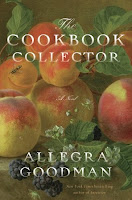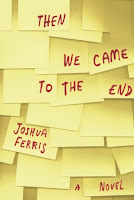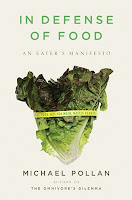 Amanda (my intern) and I will be co-reviewing the book over at Savvy Reader, just like we did for Cool Water, but I still wanted to write my own thoughts down about this exceptional novel. No, that’s not hyperbole — I truly think Lionel Shriver’s So Much For That is exceptional from start to finish. And when I did finish the book on my way home yesterday, I ended up bawling like a baby on the subway with all kinds of commuters looking at me oddly. Yes, it’s a good thing I had the physical book and not a gadget, or else they would have really thought me strange.
Amanda (my intern) and I will be co-reviewing the book over at Savvy Reader, just like we did for Cool Water, but I still wanted to write my own thoughts down about this exceptional novel. No, that’s not hyperbole — I truly think Lionel Shriver’s So Much For That is exceptional from start to finish. And when I did finish the book on my way home yesterday, I ended up bawling like a baby on the subway with all kinds of commuters looking at me oddly. Yes, it’s a good thing I had the physical book and not a gadget, or else they would have really thought me strange.
Shep Knacker has always been a self-starter. Despite his lack of a university education (his pastor father still holds the fact that he never went to college against him), he managed to build up a million-dollar handyman business before selling it to a bohunk (one that keeps him employed, more to humiliate Shep than anything else). On the eve of Shep finally taking the plunge into his ultimate dream of The Afterlife, escaping to foreign soils where he and his family would live off of the proceeds of his company’s sale, tragic news stops him in his tracks. Shep’s wife, Glynis, has never been all that supportive of The Afterlife. She resents the idea that he wants to get away from everything (modern life, her) and spend his dying days on Pemba, an island off the coast of Tanzania. So when Glynis announces that she has a very rare and very virulent form of cancer (mesothelioma) that requires immediate and expensive treatment, it’s almost a passive aggressive attack on her husband and his dreams. Upon hearing he’s about to up and leave for Pemba, has even bought the tickets, she announces almost blithely, “I do wish you wouldn’t… I’m afraid I will need your health insurance.”
The other set of main characters in the novel are Jackson, Shep’s coworker and best friend, and his family. His eldest daughter, Flicka, is a teenager who suffers from Familial Dysautonomia (FD), yet another rare and difficult disease. Carol, Jackson’s wife, is Flicka’s primary health care provider, and the family’s other daughter, Heather, often feels excluded because her sister demands so much attention. They are a typical New York family — they own a house in Brooklyn with a hefty mortgage and the couple works night and day to afford the care for their daughter, much of which isn’t covered by their combined insurance policies.
Regardless of how you might feel about the debates raging south of the border — the ridiculous “Tea Party,” the sensational news coverage by the right, the objections by the right, all of it — the idea that health care and the fundamental lack of affordable ways of getting it, form a central thesis in the novel. It’s topical and timely, but not preachy. Oh, it passes judgement but more in the sense that it allows the reader to draw her own conclusions by presenting facts and an honest, if fictional, situation.
Annnnwaaay.
In the face of their diseases, both Glynis and Flicka find comfort in one another — that’s not to say that they are “happy” by any means to be sick. The opposite, in fact, is often true, and Shriver’s uncanny ability to write characters who are at once complex and yet so unbearably human comes into sharp focus in this novel, just as it did with We Need to Talk About Kevin. The impact of the two unhealthy individuals shatters each family in different ways. The patients are angry, upset, and unflinchingly honest when they need to be about their diseases. But the road to acceptance, to leading a life where disease is always present and can never be escaped (and here’s something I know better than most), is never easy. Glynis fights to live. Sometimes, Flicka fights to die.
The moral issues Shriver explores, the sheer expense of health care in the States, the value of a human life (the millions of dollars spent on treatment), becomes so much more than a moral question — it’s the entry point for examining American society in general. From Jackson’s anti-establishment rants to Glynis’s fervent need to blame someone for her cancer (in this case, it’s the company who produced artistic supplies for her metalwork training when she was a student — they contained asbestos, the cause of her cancer). And because Shep has always paid for everything, that’s just his role in his family, he pays and pays and pays — for Glynis’s treatment, for his father’s old age home, for his sister’s heating bills (and is she ever a piece of work). No matter how hard he works, no matter how much he cares about his family, his life seems to crumble down upon him as penny by penny disappears from his Afterlife account.
At any point in this novel, there are moments when you simply don’t like the characters. You can’t believe they’re acting so selfishly, are so obtuse. And then, something happens and you see them in a different light. I’d argue that few living novelists do this as well as Shriver. She has a talent for pulling out extraordinary details in ordinary lives and writing them in a way that’s original and provocative.
As a girl who has dealt with a serious illness for all of her adult life, I couldn’t help but associate with the two characters dealing with disease. And while my Wegener’s is nowhere near as aggressive as Glynis’s cancer (because it’s moderated with medicine, unchecked it’ll kill me in terrible ways) or as impactful as Flicka’s FD (primarily because you can’t tell I’m sick by looking at me; at least I hope you can’t), the psychological warfare that disease plagues one with remains ridiculously effective throughout this entire novel. Shriver’s research reads impeccably — she writes the side effects, the symptoms, the treatments, the physical implications of each disease in such rich detail — and it’s the main reason the reader becomes so emotionally involved with this story. And the ending, well, I’m not going to spoil it — I’m only going to say it’s absolutely perfect and calls to mind the absolutely perfect ending of another exceptional novel, Barbara Kingsolver’s The Poisonwood Bible.
Highly, highly recommended. This is not a novel that will disappoint even the most cynical of readers.
WHAT’S NEXT: Ian McEwan’s Solar. I’m 30 pages in and loving the Salman Rushdie “man in midlife crisis” of it all.
 I truly admire Allegra Goodman’s storytelling techniques, and while her latest novel, The Cookbook Collector, isn’t 100% successful, it did manage to convey the same deep, emotional resonance that I found so affecting in Intuition. The novel opens deep in the heart of the Silicon Alley dot com explosion of the mid-1990s where the main protagonists in The Cookbook Collector, two radically different sisters, find themselves on opposite ends of the economic spectrum.
I truly admire Allegra Goodman’s storytelling techniques, and while her latest novel, The Cookbook Collector, isn’t 100% successful, it did manage to convey the same deep, emotional resonance that I found so affecting in Intuition. The novel opens deep in the heart of the Silicon Alley dot com explosion of the mid-1990s where the main protagonists in The Cookbook Collector, two radically different sisters, find themselves on opposite ends of the economic spectrum.







